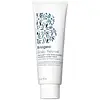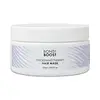What's inside
What's inside
 Key Ingredients
Key Ingredients

 Benefits
Benefits

 Concerns
Concerns

 Ingredients Side-by-side
Ingredients Side-by-side

Water
Skin ConditioningCaprylic/Capric Triglyceride
MaskingHydroxypropyl Starch Phosphate
Cetearyl Alcohol
EmollientGlyceryl Stearate
EmollientBrassica Alcohol
EmollientPropanediol
SolventGlycerin
HumectantCetyl Alcohol
EmollientCocos Nucifera Oil
MaskingCharcoal Powder
AbrasiveAloe Barbadensis Leaf Juice
Skin ConditioningMelaleuca Alternifolia Leaf Oil
AntioxidantBiotin
AntiseborrhoeicMentha Piperita Oil
MaskingMentha Viridis Leaf Oil
AstringentSodium Hyaluronate
HumectantNiacinamide
SmoothingBrassicyl Valinate Esylate
EmollientCarrageenan
Arginine
MaskingPanthenol
Skin ConditioningCetyl Hydroxyethylcellulose
Emulsion StabilisingCitric Acid
BufferingSodium PCA
HumectantGuar Hydroxypropyltrimonium Chloride
Skin ConditioningMenthyl Lactate
MaskingPlantago Lanceolata Leaf Extract
AntimicrobialPotassium Hydroxide
BufferingCalcium Gluconate
HumectantPotassium Sorbate
PreservativeSodium Benzoate
MaskingSodium Metabisulfite
AntioxidantTetrasodium Glutamate Diacetate
Sodium Glycolate
BufferingSodium Formate
BufferingSodium Hydroxide
BufferingChlorphenesin
AntimicrobialDehydroacetic Acid
PreservativeBenzyl Alcohol
PerfumingWater, Caprylic/Capric Triglyceride, Hydroxypropyl Starch Phosphate, Cetearyl Alcohol, Glyceryl Stearate, Brassica Alcohol, Propanediol, Glycerin, Cetyl Alcohol, Cocos Nucifera Oil, Charcoal Powder, Aloe Barbadensis Leaf Juice, Melaleuca Alternifolia Leaf Oil, Biotin, Mentha Piperita Oil, Mentha Viridis Leaf Oil, Sodium Hyaluronate, Niacinamide, Brassicyl Valinate Esylate, Carrageenan, Arginine, Panthenol, Cetyl Hydroxyethylcellulose, Citric Acid, Sodium PCA, Guar Hydroxypropyltrimonium Chloride, Menthyl Lactate, Plantago Lanceolata Leaf Extract, Potassium Hydroxide, Calcium Gluconate, Potassium Sorbate, Sodium Benzoate, Sodium Metabisulfite, Tetrasodium Glutamate Diacetate, Sodium Glycolate, Sodium Formate, Sodium Hydroxide, Chlorphenesin, Dehydroacetic Acid, Benzyl Alcohol
Aloe Barbadensis Leaf Juice
Skin ConditioningBehentrimonium Chloride
PreservativeCetearyl Alcohol
EmollientGlycerin
HumectantCoco-Caprylate
EmollientPropanediol
SolventCocos Nucifera Oil
MaskingArgania Spinosa Kernel Oil
EmollientButyrospermum Parkii Butter
Skin ConditioningHydrolyzed Jojoba Esters
Skin ConditioningPanthenol
Skin ConditioningNiacinamide
SmoothingSodium Hyaluronate
HumectantCeramide Ng
Skin ConditioningMacadamia Ternifolia Seed Oil
EmollientLimnanthes Alba Seed Oil
Skin ConditioningArginine
MaskingHydrolyzed Collagen
EmollientRosmarinus Officinalis Leaf Extract
AntimicrobialHydrolyzed Quinoa
Skin ConditioningHydrolyzed Adansonia Digitata Seed Extract
Ascophyllum Nodosum Extract
Skin ConditioningAmaranthus Caudatus Seed Extract
Skin ConditioningEquisetum Arvense Leaf Extract
AstringentAcanthopanax Senticosus Root Extract
Skin ConditioningBiotin
AntiseborrhoeicParfum
MaskingPolyquaternium-7
Polyquaternium-10
Pentylene Glycol
Skin ConditioningCaprylyl Glycol
EmollientEthylhexylglycerin
Skin ConditioningCitric Acid
BufferingAloe Barbadensis Leaf Juice, Behentrimonium Chloride, Cetearyl Alcohol, Glycerin, Coco-Caprylate, Propanediol, Cocos Nucifera Oil, Argania Spinosa Kernel Oil, Butyrospermum Parkii Butter, Hydrolyzed Jojoba Esters, Panthenol, Niacinamide, Sodium Hyaluronate, Ceramide Ng, Macadamia Ternifolia Seed Oil, Limnanthes Alba Seed Oil, Arginine, Hydrolyzed Collagen, Rosmarinus Officinalis Leaf Extract, Hydrolyzed Quinoa, Hydrolyzed Adansonia Digitata Seed Extract, Ascophyllum Nodosum Extract, Amaranthus Caudatus Seed Extract, Equisetum Arvense Leaf Extract, Acanthopanax Senticosus Root Extract, Biotin, Parfum, Polyquaternium-7, Polyquaternium-10, Pentylene Glycol, Caprylyl Glycol, Ethylhexylglycerin, Citric Acid
 Reviews
Reviews

Ingredients Explained
These ingredients are found in both products.
Ingredients higher up in an ingredient list are typically present in a larger amount.
Aloe Barbadensis Leaf Juice comes from leaves of the aloe plant. Aloe Barbadensis Leaf Juice is best known for helping to soothe sunburns. It is also anti-inflammatory, moisturizing, antiseptic, and can help heal wounds.
Aloe is packed with good stuff including Vitamins A, C, and E. These vitamins are antioxidants, which help fight free-radicals and the damage they may cause. Free-radicals are molecules that may damage your skin cells, such as pollution.
Aloe Barbadensis Leaf Juice also contains sugars. These sugars come in the form of monosaccharides and polysaccharides, folic acid, and choline. These sugars are able to help bind moisture to skin.
It also contains minerals such as calcium, 12 anthraquinones, fatty acids, amino acids, and Vitamin B12.
Learn more about Aloe Barbadensis Leaf JuiceArginine is an amino acid that is important for human development. Your body uses is it to produce hair keratin and skin collagen.
As a cosmetic ingredient, Arginine has antioxidant properties and can also help repair damaged skin. This ingredient is derived either synthetically or from animals.
Arginine isn't fungal acne safe when used in the presence of other lipids (fats, fatty acids, oils, esters, etc). Oils and fats occur naturally within the skin, so take caution when using Arginine if you're prone to fungal acne.
Learn more about ArginineBiotin is a B vitamin that is naturally produced by our bodies. It is also called Vitamin H.
Our bodies use biotin in the metabolism process. It also helps our bodies use enzymes and move nutrients around. A biotin deficiency can lead to brittle hair and nails.
More research is needed on applying biotin topically. However, taking biotin orally has been shown to help nourish the skin, hair, and nails. They play a role in forming skin-hydrating fatty acids.
Biotin is water-soluble. It can be found in foods such as fish, eggs, dairy, nuts, and meat. Vitamin H stands for "haar" and "haut". These are the German words for hair and skin.
Learn more about BiotinCetearyl alcohol is a mixture of two fatty alcohols: cetyl alcohol and stearyl alcohol. It is mainly used as an emulsifier. Emulsifiers help prevent the separation of oils and products. Due to its composition, it can also be used to thicken a product or help create foam.
Cetearyl alcohol is an emollient. Emollients help soothe and hydrate the skin by trapping moisture.
Studies show Cetearyl alcohol is non-toxic and non-irritating. The FDA allows products labeled "alcohol-free" to have fatty alcohols.
This ingredient is usually derived from plant oils such as palm, vegetable, or coconut oils. There is debate on whether this ingredient will cause acne.
Due to the fatty acid base, this ingredient may not be Malassezia folliculitis safe.
Learn more about Cetearyl AlcoholCitric Acid is an alpha hydroxy acid (AHA) naturally found in citrus fruits like oranges, lemons, and limes.
Like other AHAs, citric acid can exfoliate skin by breaking down the bonds that hold dead skin cells together. This helps reveal smoother and brighter skin underneath.
However, this exfoliating effect only happens at high concentrations (20%) which can be hard to find in cosmetic products.
Due to this, citric acid is usually included in small amounts as a pH adjuster. This helps keep products slightly more acidic and compatible with skin's natural pH.
In skincare formulas, citric acid can:
While it can provide some skin benefits, research shows lactic acid and glycolic acid are generally more effective and less irritating exfoliants.
Most citric acid used in skincare today is made by fermenting sugars (usually from molasses). This synthetic version is identical to the natural citrus form but easier to stabilize and use in formulations.
Read more about some other popular AHA's here:
Learn more about Citric AcidCocos Nucifera Oil is obtained from the kernels of the coconut fruit. In other words, this is coconut oil.
Coconut Oil is rich in fatty acids with lauric acid making up the majority of these. It also contains linoleic acid. Due to this high fatty acid content, coconut oil helps trap moisture and soften skin.
Despite being antibacterial, coconut oil may not be great for acne-prone skin. It is comedogenic and may clog pores. This ingredient may not be safe for malassezia or fungal acne.
Note: Coconut Oil should not replace your sunscreen for UV protection. Studies show it only blocks about 20% of UV.
This oil is non-volatile and has a light scent.
The term 'fragrance' is not regulated in many countries. In many cases, it is up to the brand to define this term. For instance, many brands choose to label themselves as "fragrance-free" because they are not using synthetic fragrances. However, their products may still contain ingredients such as essential oils that are considered a fragrance.
Learn more about Cocos Nucifera OilGlycerin is already naturally found in your skin. It helps moisturize and protect your skin.
A study from 2016 found glycerin to be more effective as a humectant than AHAs and hyaluronic acid.
As a humectant, it helps the skin stay hydrated by pulling moisture to your skin. The low molecular weight of glycerin allows it to pull moisture into the deeper layers of your skin.
Hydrated skin improves your skin barrier; Your skin barrier helps protect against irritants and bacteria.
Glycerin has also been found to have antimicrobial and antiviral properties. Due to these properties, glycerin is often used in wound and burn treatments.
In cosmetics, glycerin is usually derived from plants such as soybean or palm. However, it can also be sourced from animals, such as tallow or animal fat.
This ingredient is organic, colorless, odorless, and non-toxic.
Glycerin is the name for this ingredient in American English. British English uses Glycerol/Glycerine.
Learn more about GlycerinNiacinamide is a multitasking form of vitamin B3 that strengthens the skin barrier, reduces pores and dark spots, regulates oil, and improves signs of aging.
And the best part? It's gentle and well-tolerated by most skin types, including sensitive and reactive skin.
You might have heard of "niacin flush", or the reddening of skin that causes itchiness. Niacinamide has not been found to cause this.
In very rare cases, some individuals may not be able to tolerate niacinamide at all or experience an allergic reaction to it.
If you are experiencing flaking, irritation, and dryness with this ingredient, be sure to double check all your products as this ingredient can be found in all categories of skincare.
When incorporating niacinamide into your routine, look out for concentration amounts. Typically, 5% niacinamide provides benefits such as fading dark spots. However, if you have sensitive skin, it is better to begin with a smaller concentration.
When you apply niacinamide to your skin, your body converts it into nicotinamide adenine dinucleotide (NAD). NAD is an essential coenzyme that is already found in your cells as "fuel" and powers countless biological processes.
In your skin, NAD helps repair cell damage, produce new healthy cells, support collagen production, strengthen the skin barrier, and fight environmental stressors (like UV and pollution).
Our natural NAD levels start to decline with age, leading to slower skin repair, visible aging, and a weaker skin barrier. By providing your skin niacinamide, you're recharging your skin's NAD levels. This leads to stronger, healthier, and younger looking skin.
Another name for vitamin B3 is nicotinamide. This vitamin is water-soluble and our bodies don't store it. We obtain Vitamin B3 from either food or skincare. Meat, fish, wheat, yeast, and leafy greens contain vitamin B3.
The type of niacinamide used in skincare is synthetically created.
Learn more about NiacinamidePanthenol is a common ingredient that helps hydrate and soothe the skin. It is found naturally in our skin and hair.
There are two forms of panthenol: D and L.
D-panthenol is also known as dexpanthenol. Most cosmetics use dexpanthenol or a mixture of D and L-panthenol.
Panthenol is famous due to its ability to go deeper into the skin's layers. Using this ingredient has numerous pros (and no cons):
Like hyaluronic acid, panthenol is a humectant. Humectants are able to bind and hold large amounts of water to keep skin hydrated.
This ingredient works well for wound healing. It works by increasing tissue in the wound and helps close open wounds.
Once oxidized, panthenol converts to pantothenic acid. Panthothenic acid is found in all living cells.
This ingredient is also referred to as pro-vitamin B5.
Learn more about PanthenolPropanediol is an all-star ingredient. It softens, hydrates, and smooths the skin.
It’s often used to:
Propanediol is not likely to cause sensitivity and considered safe to use. It is derived from corn or petroleum with a clear color and no scent.
Learn more about PropanediolSodium Hyaluronate is hyaluronic acid's salt form. It is commonly derived from the sodium salt of hyaluronic acid.
Like hyaluronic acid, it is great at holding water and acts as a humectant. This makes it a great skin hydrating ingredient.
Sodium Hyaluronate is naturally occurring in our bodies and is mostly found in eye fluid and joints.
These are some other common types of Hyaluronic Acid:
Learn more about Sodium Hyaluronate